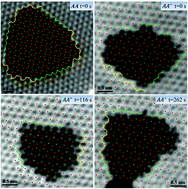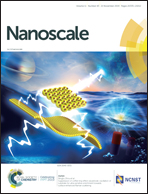Direct imaging of the nitrogen-rich edge in monolayer hexagonal boron nitride and its band structure tuning†
Abstract
Identification of edge atoms and tracking the edge structure evolution of two-dimensional (2D) crystals at the scale of individual atoms is critical for understanding the edge-dominated properties and behavioral responses to external field stimuli. Here, direct imaging of the edge configuration of monolayer hexagonal boron nitride (h-BN) is demonstrated at the atomic scale, by using aberration-corrected transmission electron microscopy. Tracking of the edge atoms revealed that a nitrogen-terminated zigzag arrangement dominates along the edge, naturally leading to nitrogen rich (N-rich) characteristics in this area, while the stoichiometric interior of the h-BN monolayer is maintained. Both top-down fabrication and bottom-up growth were proposed to obtain novel h-BN flakes with an N-rich ratio larger than 1% when the size is reduced to the threshold of 25 nm. Furthermore, density functional theory calculations revealed that a new bandgap of ∼3 eV is created by the N-rich characteristics, and h-BN transforms into an n-type semiconductor by self-doping. The results call for the development of ultra-small h-BN islands to be used in intriguing 2D electronic devices with a photoresponse function to visible light.



 Please wait while we load your content...
Please wait while we load your content...